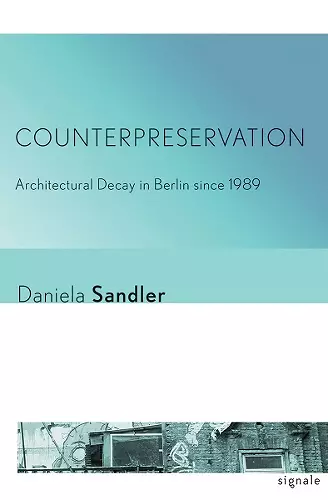Counterpreservation
Architectural Decay in Berlin Since 1989
Format:Paperback
Publisher:Cornell University Press
Published:15th Dec '16
Currently unavailable, and unfortunately no date known when it will be back
This paperback is available in another edition too:
- Hardback£96.00(9781501703164)

In Counterpreservation, Daniela Sandler examines how Berlin's decaying buildings are creatively repurposed, challenging traditional urban narratives and encouraging community involvement.
In Berlin, dilapidated buildings often serve a purpose beyond mere decay. Rather than being seen as symbols of urban decline, these structures are creatively integrated into daily life, functioning as homes, exhibition spaces, shops, offices, and leisure areas. In Counterpreservation, Daniela Sandler explores the concept of counterpreservation, which allows for a deeper understanding of how these forgotten spaces are intentionally repurposed and embraced by the community.
These decaying edifices act as platforms for public dialogue, fostering discussions about Berlin's past and future. They are not only a testament to the city’s rebellious spirit but also play a significant role in its tourism and development landscape, blending counterculture with mainstream appeal. Sandler examines both the strengths and limitations of counterpreservation, suggesting that it could serve as a model for other urban environments facing similar challenges.
The notion of counterpreservation is woven into the very fabric of Berlin, visible in the city's renowned Hausprojekte, cultural centers, memorials, and even commercial spaces. This appropriation of ruins creates affordable living and working spaces while simultaneously challenging gentrification and chronicling the city's multifaceted history. Through various examples, Counterpreservation prompts readers to reconsider traditional views of architectural authorship and highlights the importance of community engagement in shaping urban landscapes.
Sandler concludes with a brilliantly argued case for the worldwide significance of counterpreservation as a conceptual force that challenges the fundamental tenets of historic preservation as it is practiced in the West today.
(Choice)Sandler imagines how architecture might grapple with the concept of transience, creating buildings that show the futility of hanging on to the past.... Any good contemporary reading of Berlin must come to grips with the city's relationship to its own decay. Sandler's accessible, smart book deserves a place on the reading list for the thoughtful kind of Berlin tourist, for student study abroad groups, and for those writing about the many rises and falls that have happened in the capital city of what has come to be known as 'The Berlin Republic.'
(The German Quarterly)Sandler sees a categorical difference between counterpreservation and the fascination with ruins and ancient monuments inherent in some traditional conservationist approaches.... In general Sandler's book stands out for her perspicacious perspective, which is also related to the fact that she looks at the city from the perspective of an outsider.... A must-read for any student or scholar interested in Berlin's history and the fascinating ways in which the past manifests in the city's urban fabric.
(Planning Perspectives)Daniela Sandler presents rugged methods of stewardship and alteration of Berlin buildings that constitute a 'reflective nostalgia' instead of a 'restorative nostalgia,' revealing preservation as a productive practice with its own embedded political and cultural editorial power.... May spur the field to reconsider that very basic mode of always interrogating, sometimes appreciating, and often conserving heritage artifacts as we find them—which has long been called simply preservation.
(buildings & landsca- Winner of Antoinette Forrester Downing Award 2018 (United States)
ISBN: 9781501703171
Dimensions: 229mm x 152mm x 19mm
Weight: 454g
274 pages